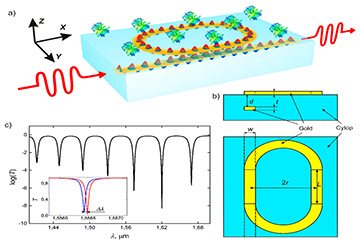Biosensor layout (a, b). The waveguide is inside the dielectric substrate. The resonator, realized as a ring waveguide, is positioned at the interface between the dielectric material and the biological fluid that is analyzed. A change in the fluid's refractive index shifts the resonant curve (c). [Image: Kirill Voronin et al./Sensors][Enlarge image]
Athletes and exercise aficionados have long wished for a digital dashboard that could monitor their bodily fluids like sweat and saliva, and thus their bodies’ performance, like the instrument panel in an aircraft. Except for blood-glucose meters for diabetic patients, though, such sensors have not yet reached the consumer marketplace because of expense and lack of sensitivity.
A research team at a Russian university has proposed a new design for an optical biosensor that could simplify and lower the cost of such devices (Sensors, doi: 10.3390/s20010203). The small, dual-level plasmonic instrument is easier and less expensive to fabricate than previous designs and can be configured for high sensitivity.
Pursuing novel plasmonic structures
Most optical biosensors work by adsorbing substances such as sweat onto the surface of the device and measuring changes in the refractive index of the substances. Surface plasmon resonance has become the basis of existing biosensors, although the resulting detectors are generally too large, and too reliant on moving parts, to incorporate into portable digital devices. As a result, scientists have begun to investigate plasmon microresonators as a possible compact configuration for the next generation of biosensors.
Kirill Voronin, Aleksey Arsenin and their colleagues at the Moscow Institute of Physics and Technology (MIPT), Russia, tried a new configuration: Instead of incorporating the ring resonator into the same plane of their prototype biosensor as the waveguide, they stacked the two on different planes, with one side of the oval ring on top of the waveguide. The vertical stacking effectively couples the ring and waveguide, both made of thin gold films in a dielectric substrate.
However, the resonance in the ring changes with the refractive index of adsorbed organic molecules, and that small change can be calculated from small peak shifts in transmission spectra. The Russian team members calculated that their dual-layer biosensor scheme has a sensitivity of 1200 nm per refractive index unit, roughly twice that of a typically arranged plasmonic resonator biosensor.
Toward a commercial wearable device
According to the MIPT team, the stacked biosensor architecture is easy to fabricate with standard layer-by-layer manufacturing methods. The authors suggest other avenues for experimental exploration, such as supplementing the plasmonic waveguide with a photonic waveguide.

